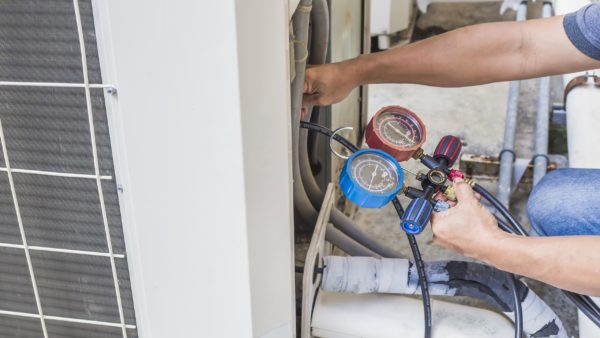R-22 vs R-410A: Is There a Difference?

Older AC systems used to use R-22, whereas nowadays air conditioners use R-410A. Both of these chemicals are refrigerants, which is what AC systems use to absorb heat. The use of R-22 has been almost completely banned, and R-410A is also about to be phased out. To understand why this is, let’s look at how these chemicals work and the differences between R-22, R-410A and other refrigerants.
Understanding the Importance of Refrigerant to Your AC System
Whether it is R-22, R-410A or another refrigerant, these chemicals are what allow your AC system to cool your home. Air conditioners use a process known as heat transfer to capture heat from the air inside your home. The heat transfer process also works to allow the AC condenser to disperse this heat back outside.
Due to the laws of physics, heat energy naturally flows to any areas or surfaces that are at a lower temperature. To cool your home, your AC compresses a gas refrigerant into a liquid. This releases any heat and instantly cools the refrigerant.
Inside your home is an evaporator coil, which is filled with this cold refrigerant. Since the air being drawn into the system is hotter than the refrigerant, the heat naturally flows from the air into the refrigerant. As a result, the air that the AC system pumps out of your supply vents is much cooler than the air that it draws in through the return air vents. All of this cold air slowly cools the home since heat is being extracted from the building and transferred outside.
What Is R-22 and Why Was It Banned?
R-22 was the main refrigerant used in air conditioners, refrigerators, freezers and other cooling equipment for many years. This chemical is most commonly known by its brand name, Freon. If you know anything about Freon, you are probably aware that it was one of the biggest contributing factors to the hole in the ozone layer.
R-22 is a type of chemical compound known as a hydrochlorofluorocarbon (HCFC). Freon and other HCFCs have powerful ozone-depleting properties, which means that they destroy the gas that forms the ozone layer.
Under the 1987 Montreal Protocol, countries across the globe pledged to work to protect the ozone layer from further depletion. One major part of this treaty was to slowly phase out Freon and other HCFCs since these were one of the main causes of ozone depletion. The treaty was quickly signed by the US and almost every other country in the world.
Although the treaty went into effect in 1989, the US and most other nations didn’t actually start to phase out Freon until a few decades later. In the US, the Freon phase-out began in 2010, and the production of Freon was fully banned in 2020. However, the use of Freon is still legal as long as it has been reclaimed and recycled from another source.
In practical terms though, very few people still use R-22 partly because its supply is so scarce. If your AC unit was installed before 2010, it most likely still uses Freon. This means that if your unit is low on refrigerant, it is usually necessary to first reclaim the R-22 and then fill the system back up with R-410A. In most cases, you would be far better off simply replacing the old unit instead.
How Is R-410A Different?
After R-22 was phased out in 2010, most all AC units switched to using R-410A instead. This refrigerant is a hydrofluorocarbon (HFC), and it and other HFCs are used because they don’t cause any harm to the ozone layer. In fact, most scientists agree that the switch from HCFCs to HFCs is one of the biggest reasons why the ozone layer has slowly recovered.
While HFCs don’t affect the ozone layer, they are still some of the worst, most powerful greenhouse gases known to man and are a direct contributor to climate change. This is why the world has now also pledged to slowly begin phasing out all HFCs as well.
In 2016, the majority of the world’s countries signed the Kigali Amendment, which adds on to the original Montreal Protocol. This treaty sets guidelines for decreasing the use of HFCs in an effort to slow global temperature increases. The US has not yet signed this amendment, but it pledged to do so in 2021. It is expected that this will happen in the next year or so.
Despite not signing the treaty yet, the US has announced that the country will begin phasing out R-410A starting on January 1, 2023. As with R-22, it will most likely be at least a decade before R-410A is banned altogether. Nonetheless, AC manufacturers have already begun making plans to design equipment that use alternative types of refrigerants.
As a consumer, nothing will change for you for at least a few years. If your current AC unit develops a refrigerant leak, it will still be possible to fill it back up with R-410A. However, if you have your AC unit replaced say five years from now, there is a good chance that it will use some either type of refrigerant.
Even then, nothing will really change in terms of how your AC system works, just like there was no noticeable difference when the HVAC industry switched from R-22. The real difference will be for HVAC technicians as they will eventually need to be trained to safely handle and use the new refrigerants.
New Refrigerant Options
In all likelihood, R-410A will be replaced by either R-454B or R-32 unless a better option is developed in the next few years. Both of these compounds are also HFCs, which means they will still contribute to climate change. However, they are nowhere near as powerful of greenhouse gases as R-410A, which means the negative effect will at least be reduced.
When looking at the impact of greenhouse gases, scientists focus on two things. The first is ODP or Ozone Depletion Potential. While R-22 has a very high ODP, all HFCs have an ODP of 0. This means that they cause zero damage to the ozone layer.
The other metric is GWP or Global Warming Potential. Scientists use carbon dioxide as the baseline when measuring GWP. The GWP of CO2 is 1, whereas R-410A has a GWP of 1,890. R-22 has a GWP of 1,810. This means that these two compounds trap nearly 2,000 times more heat in the atmosphere than carbon dioxide.
R-454B and R-32 are still much more powerful than carbon dioxide but still not nearly as bad as R-410A or R-22. The GWP of R-32 is 675. R-454B is even lower with a GWP of 466. Even if the ultimate goal is to completely transition away from HFCs altogether, switching to these less harmful options should still help to reduce the risk to the planet.
Expert AC Services in O’Fallon
The difference between R-22 and R-410A isn’t something you really need to worry about. The only time that it will even be a factor is if your AC system is old enough that it still uses Freon. If you’re unsure about which refrigerant your AC uses, the team at Hoff Heating & AC can check for you. If you have an old AC that does use Freon, we recommend you start thinking about replacing it. After all, most AC units only last around 15 years. This means that any unit that still uses Freon will likely fail fairly soon anyway.
Our NATE-certified HVAC technicians are ready to help with your AC replacement or installation needs. We also repair and service all AC models from any manufacturer, and our team can also maintain your system to ensure your home stays cool and comfortable. If you have any questions or need any cooling or heating service, give us a call today.

 Call Us Today
Call Us Today
